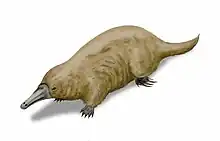Theriiformes
Theriiformes is a clade of mammals. The term was coined by Timothy B. Rowe in his doctoral dissertation,[1] and is defined as the clade formed by the most recent common ancestor of multituberculates (which form part of the broader group Allotheria) and therians, and all its descendants. Mammals more closely related to therians than to multituberculates are included in the clade Trechnotheria.[2]
| Theriiformes Temporal range: | |
|---|---|
 | |
| Skull of the multituberculate Ptilodus (Allotheria) | |
 | |
| Skeleton of Maotherium (Trechnotheria) | |
| Scientific classification | |
| Domain: | Eukaryota |
| Kingdom: | Animalia |
| Phylum: | Chordata |
| Class: | Mammalia |
| Clade: | Theriimorpha |
| Clade: | Theriiformes Rowe, 1988 |
| Subgroups | |
The cladogram below follows Luo et al. (2016):[3]
| Mammalia |
| ||||||||||||||||||||||||||||||||||||||||||
References
- Rowe, T. (1988). "Definition, diagnosis, and origin of Mammalia". Journal of Vertebrate Paleontology. 8 (3): 241–264. doi:10.1080/02724634.1988.10011708.
- Macrini, T. E.; Rougier, G. W.; Rowe, T. (2007). "Description of a Cranial Endocast from the Fossil Mammal Vincelestes neuquenianus (Theriiformes) and its Relevance to the Evolution of Endocranial Characters in Therians". The Anatomical Record: Advances in Integrative Anatomy and Evolutionary Biology. 290 (7): 875–892. doi:10.1002/ar.20551.
- Luo, Zhe-Xi; Schultz, Julia A.; Ekdale, Eric G. (2016). "Evolution of the Middle and Inner Ears of Mammaliaforms: The Approach to Mammals". In Clack, Jennifer A.; Fay, Richard R.; Popper, Arthur N. (eds.). Evolution of the Vertebrate Ear. Vol. 59. pp. 139–174. doi:10.1007/978-3-319-46661-3_6.
This article is issued from Wikipedia. The text is licensed under Creative Commons - Attribution - Sharealike. Additional terms may apply for the media files.



